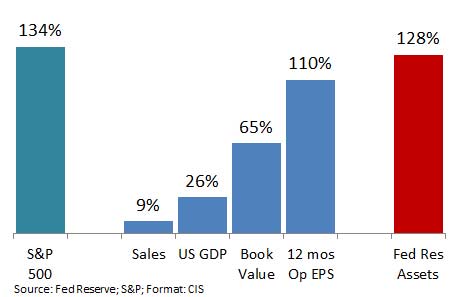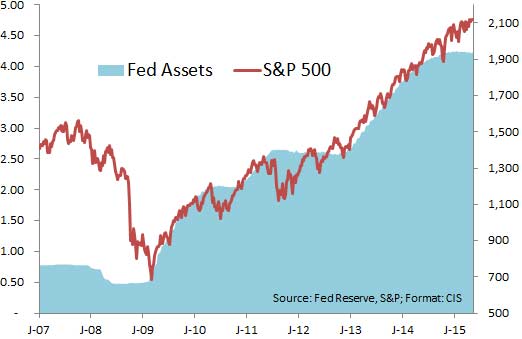Do Not Expect the Stock Growth of Recent Years to Continue
What drove the incredible returns that stocks posted from the end of 2008 through September 2015? Nothing real.

"Men, it has been well said, think in herds; it will be seen that they go mad in herds, while they only recover their senses slowly, one by one." ― Charles Mackay, Extraordinary Popular Delusions and the Madness of Crowds
Since the end of 2008 through the third quarter of 2015, Standard & Poor's 500-stock index was up about 134%. Very impressive. Many will see this number and not inquire further. We see the number in the context of other numbers and wonder how in the world it did it. What drove the market up for six years? Was it earnings? Was it a great economy? Was it value?
Let's examine the economy, in terms of gross domestic product (GDP). According to the Federal Reserve, the GDP grew 26% since the beginning of 2009, an average of 3.36% annually. The stock market grew more than five times what the economy grew. Economic growth was hardly a catalyst for the market's performance.
From just $107.88 $24.99 for Kiplinger Personal Finance
Become a smarter, better informed investor. Subscribe from just $107.88 $24.99, plus get up to 4 Special Issues

Sign up for Kiplinger’s Free Newsletters
Profit and prosper with the best of expert advice on investing, taxes, retirement, personal finance and more - straight to your e-mail.
Profit and prosper with the best of expert advice - straight to your e-mail.
Next let's look at earnings. We have heard great things about earnings for the past few years. The S&P 500's operating earnings grew 110% since 2008. However, that high jump is really just some balance sheet gymnastics; the starting point for that period of gains was when earnings were crushed due to the 2008 bear market. If you look at the index's performance from the previous market peak in June 2007 through September 2015, earnings are up only 13.85% total while the market is up 33.15%, almost 2.5 times the earnings growth. This gives a more realistic view of the long-term earnings growth. Earnings were up, but the market was up a lot more. Earnings weren't the catalyst.
Since earnings did grow, sales must have been up considerably, right? S&P data shows sales were up 9% total. Not annually, total—from the end of 2008 through the third quarter of 2015, there was only 9% sales growth. This meager sales figure gives further credence to the belief that much of the earnings over the past several years have been due to balance sheet and income statement manipulations rather than good old-fashioned business growth. Sales weren't the catalyst.
Was the market a great value in 2009? The cyclically adjusted price-earnings ratio, which is a measurement of value that was devised by Yale finance professor Robert Shiller as a way of normalizing earnings, hit a low of about 13.32. Also known as the Shiller P/E, its previous bottoms were in the single digits—for example, 6.64 in 1982, 5.57 in 1932 and 4.78 in 1921. Each bottom was less than half the 2009 low. So no, the 2009 low was no great bargain. And the Shiller P/E has doubled since 2009.
So what was the main catalyst of the market rally?
Our research shows that it was liquidity from the Fed. As the Fed pumped liquidity into the system, that liquidity found its way into stocks. The only number that comes close to having an impact on the value of stocks is the Fed's increasing its balance sheet by 128% since the beginning of 2009 (as shown in the chart below).

You can see just how much of an impact the Fed's buying binge had on the market. The chart below shows that when the Fed slowed its buying of assets, the market stalled, and when it started buying again, the market took off. Today the Fed has slowed its buying, and the market is going through some wild volatility.

(Some may retort, "But the markets made money for the past six years, so they did something right?!" To those people, I will point out that heroin dealers also make money, but it doesn't mean how they did it was right. The Fed has been acting more like a drug dealer for the past decade or more, and the markets have been its shady street corner. Investors are hooked on what the Fed is selling.)
What does this mean? Today's market is way out of whack with reality: sales growth, earnings growth and economic growth clearly do not track with the stock growth of recent years. Even with the latest correction, the market is still bloated. For it all to make sense, sales would need to catch up, showing that companies are focused on actually growing their businesses and creating better value, and the economy would need to suddenly accelerate. Otherwise, the market needs to become "real" again. This means stocks would have to fall back to where they belong, based on historical norms—to match the economic reality, that means the market could go 30% to 60% lower.
So what does an investor do? Realize that what we witnessed the past few years wasn't real, and do not expect it to continue. Carefully review your holdings and reduce risks. Eliminate the most overvalued holdings first. Don't forget to look at your mutual funds—they are made up of stocks and can be just as overvalued. Being in a mutual fund doesn't keep them from declining to normal levels.
Of course the Fed could step in and make an artificial market even more so. Could it come to the rescue again? Does it not see the damage they have already done to the markets? Does it not realize that pumping up its balance sheet only resulted in a meager increase in the economy and sales revenue, that its policy failed?
The Fed may very well be out of ammunition to prop up the economy and market. Those that are waiting for it to rescue the markets again could be sorely disappointed.
John Riley, registered Research Analyst and the Chief Investment Strategist at CIS, has been defending his clients from the surprises Wall Street misses since 1999.
Disclosure: Third party posts do not reflect the views of Cantella & Co Inc. or Cornerstone Investment Services, LLC. Any links to third party sites are believed to be reliable but have not been independently reviewed by Cantella & Co. Inc or Cornerstone Investment Services, LLC. Securities offered through Cantella & Co., Inc., Member FINRA/SIPC. Advisory Services offered through Cornerstone Investment Services, LLC's RIA. Please refer to my website for states in which I am registered.
Profit and prosper with the best of Kiplinger's advice on investing, taxes, retirement, personal finance and much more. Delivered daily. Enter your email in the box and click Sign Me Up.

In 1999, John Riley established Cornerstone Investment Services to offer investors an alternative to Wall Street. He is unique among financial advisers for having passed the Series 86 and 87 exams to become a registered Research Analyst. Since breaking free of the crowd, John has been able to manage clients' money in a way that prepares them for the trends he sees in the markets and the surprises Wall Street misses.
-
 My Top 10 Stock Picks for 2026
My Top 10 Stock Picks for 2026Each year, we ask an expert to pick 10 stocks that have the potential to beat the market over the next 12 months. Here are his choices for 2026.
-
 Special Report: The Future of American Politics
Special Report: The Future of American PoliticsThe Kiplinger Letter The Political Trends and Challenges that Will Define the Next Decade
-
 We're Still Bullish on Stocks
We're Still Bullish on StocksWe're still bullish on stocks for 2026, but now is the time for investors to pull in their horns and dial down risk.
-
 Now That You've Built Your Estate Planning Playbook, It's Time to Put It to Work
Now That You've Built Your Estate Planning Playbook, It's Time to Put It to WorkYou need to share details with your family (including passwords and document locations) and stay focused on keeping your plan up to date.
-
 I'm a Wealth Adviser: These 10 Strategies Can Help Women Prepare for Their Impending Financial Power
I'm a Wealth Adviser: These 10 Strategies Can Help Women Prepare for Their Impending Financial PowerAs women gain wealth and influence, being proactive about financial planning is essential to address longevity and close gaps in confidence and caregiving.
-
 I'm a Financial Planning Pro: This Is How You Can Stop These 5 Risks From Wrecking Your Retirement
I'm a Financial Planning Pro: This Is How You Can Stop These 5 Risks From Wrecking Your RetirementYour retirement could be jeopardized if you ignore the risks you'll face later in life. From inflation to market volatility, here's what to prepare for.
-
 Are You Hesitating to Spend Money You've Spent Years Saving? Here's How to Get Over It, From a Financial Adviser
Are You Hesitating to Spend Money You've Spent Years Saving? Here's How to Get Over It, From a Financial AdviserEven when your financial plan says you're ready for a big move, it's normal to hesitate — but haven't you earned the right to trust your plan (and yourself)?
-
 Time to Close the Books on 2025: Don't Start the New Year Without First Making These Money Moves
Time to Close the Books on 2025: Don't Start the New Year Without First Making These Money MovesAs 2025 draws to a close, take time to review your finances, maximize tax efficiency and align your goals for 2026 with the changing financial landscape.
-
 Is Fear Blocking Your Desire to Retire Abroad? What to Know to Turn Fear Into Freedom
Is Fear Blocking Your Desire to Retire Abroad? What to Know to Turn Fear Into FreedomCareful planning encompassing location, income, health care and visa paperwork can make it all manageable. A financial planner lays it all out.
-
 How to Master the Retirement Income Trinity: Cash Flow, Longevity Risk and Tax Efficiency
How to Master the Retirement Income Trinity: Cash Flow, Longevity Risk and Tax EfficiencyRetirement income planning is essential for your peace of mind — it can help you maintain your lifestyle and ease your worries that you'll run out of money.
-
 I'm an Insurance Expert: Sure, There's Always Tomorrow to Report Your Claim, But Procrastination Could Cost You
I'm an Insurance Expert: Sure, There's Always Tomorrow to Report Your Claim, But Procrastination Could Cost YouThe longer you wait to file an insurance claim, the bigger the problem could get — and the more leverage you're giving your insurer to deny it.